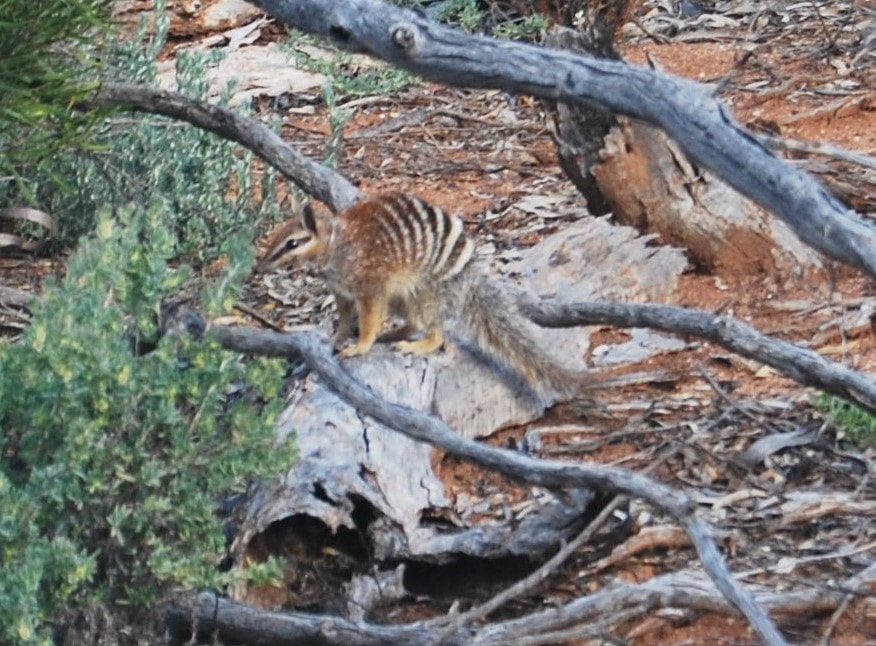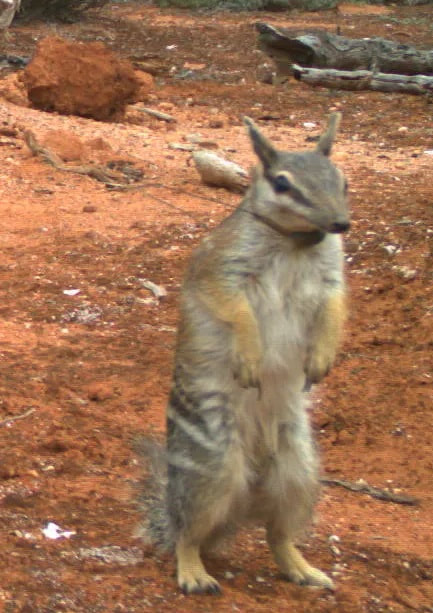|
3 September, 2022
I wish all Dads could… have the type of afternoon I just enjoyed with my 12 year old daughter. I’d promised Jarrah we would go looking for one of Australia’s rarest and cutest mammals. Whilst waiting for the fog to lift we’d moved a Felixer to target a feral cat spotted on a camera outside our cat-proof fence. For, unlike any of our other rare marsupials, the sun had to poke through the low cloud before numbats emerge. A few weeks ago our workmate Cat Lynch had picked up three numbats flown over from Perth. These were old numbats, surplus to the Perth Zoo’s needs, like green-collared greyhounds or ex-racehorses needing a back paddock to retire. We were happy to oblige. These retirees allowed Katherine and Cat to trial special new adjustable radiocollars, prior to a larger numbat reintroduction planned for later this year. They also let us assess whether the country rehabilitating rapidly from the big fires two and a half years ago would be suitable. The platypus is often joked about as being concocted by committee, but the numbat must vie for the title of Australia’s most bizarre mammal. Their tail could be grafted from a squirrel, their rump is adorned with exquisite zebra-like white bands and their tongue is turbo-charged and echidna-like. And, fortunately for numbat watchers, they only come out when its warm and sunny, like thorny devils. Although each evening we confirmed they had found safe shelters, we had deliberately not checked on our new numbats for the first few weeks. Until they had found plenty of hollow logs to hide in, we were worried that they could be picked off by falcons or goshawks if they ran blindly away from us. The ever louder beeps of our radiotracker led us to hollow logs under really old mallees. Jarrah and I stopped and looked, knowing our quarry was less than twenty metres away. And we waited and watched. Then Jarrah spotted it. Frozen motionless by the logs, we were amazed that the boldly banded, orange beast with a flamboyant fluffy tail could hide. Then, as if deciding we represented no threat, Saul (that’s the name he came with) showed his tricks. Standing high on his back legs like a meercat, Saul checked us out. With tail held aloft he then walked, long-legged but soft-footed, to a log, jumping up to show off in the sun. From his elevated perch Saul obviously saw something he liked and meandered off, sniffing at sticks as he walked. I was watching through binoculars and only noticed how close he had come to Jarrah when she came into view. Motionless, and transfixed by the action she was observing through her new phone, I watched Jarrah’s concentration dissolve into a broad grin when Saul nosily slurped at termites under a barky stick in front of her. We had agreed not to follow the numbats as they moved off. As I noted Saul’s GPS coordinates on our datasheet, Jarrah skipped over and gave me a high five. “Fully sick” she exclaimed, although I’d made no such diagnosis. I’m not sure whether I was more delighted at her reaction or my first close-up experience with a wild numbat. Now restricted to a small pocket of south-west Western Australia and a handful of fenced safehavens, numbats had not delighted anyone on Eyre Peninsula for over a century. And I got to share the experience with Jaz. Now engaged and engrossed, heading off to find the other numbats, we discussed how dependent they are on the special conditions we could offer. Only half the size of a rabbit, numbats make little more than a snack for foxes and feral cats that we had fenced out and removed. We walked away from the monster old mallees to an area that must have had a cool burn 60-80 years ago. The dead hollows remaining from that fire now provided shelter for our geriatric numbats, all these years later. The shrubs regenerating after goats had been removed provided them cover from birds of prey. Even the scattering of finger-sized sticks, the sort I had collected for kindling without a thought, seemed to host many of the termites our new friends depended upon. Hopefully Saul and his two mates will be the first of many numbats to eventually thrill kids and parents alike on Eyre Peninsula. Hopefully their endearing looks and behaviour will encourage widespread control of foxes and cats, proactive use of control burns to prevent disastrous wildfires and removal of livestock, goats and even deer and overabundant kangaroos from enough scrub patches to entice more kids away from messaging their friends and playing Subway Surfers, if only for a couple of sunny hours on a weekend.
1 Comment
|
Details
John L. Read, PhD, author-ecologistWakefield Press, Dear Grandpa, Why? Reflections From Kokoda to Hiroshima Archives
March 2023
Categories |


 RSS Feed
RSS Feed
